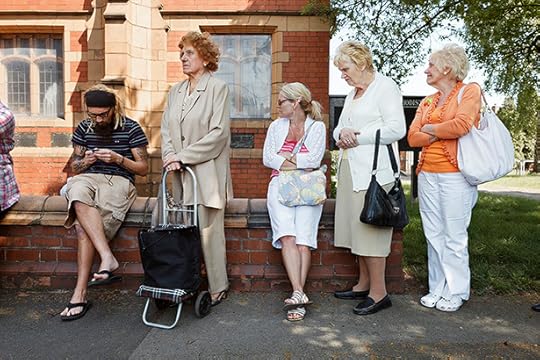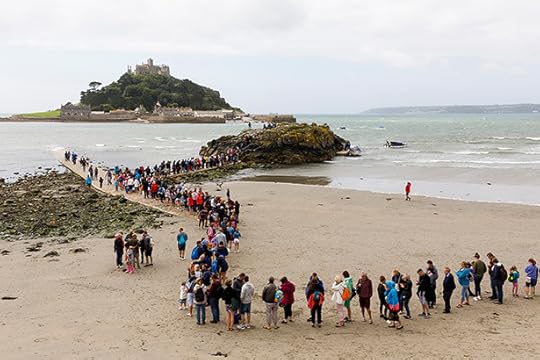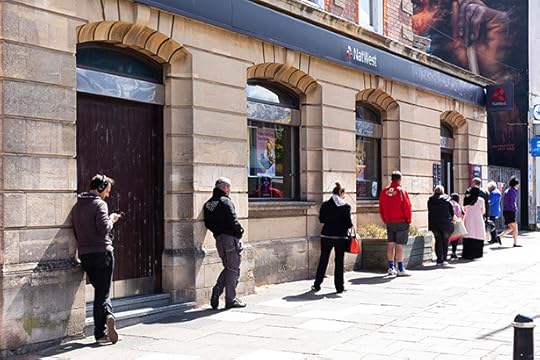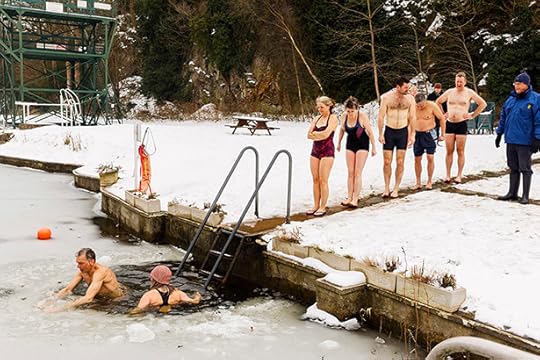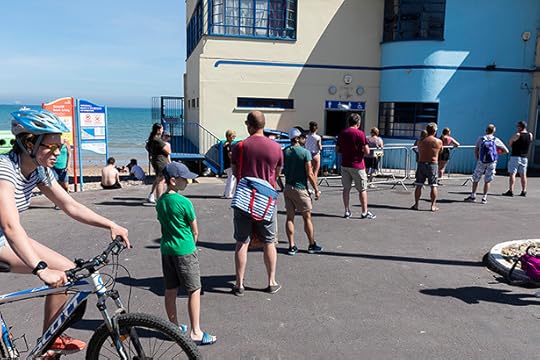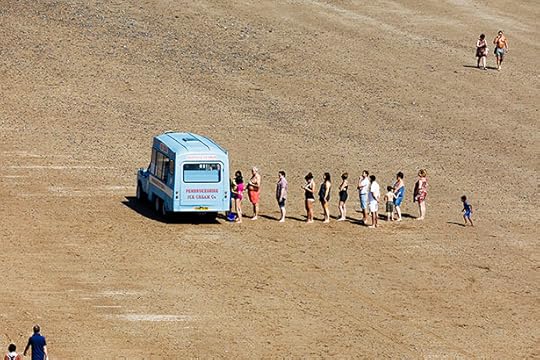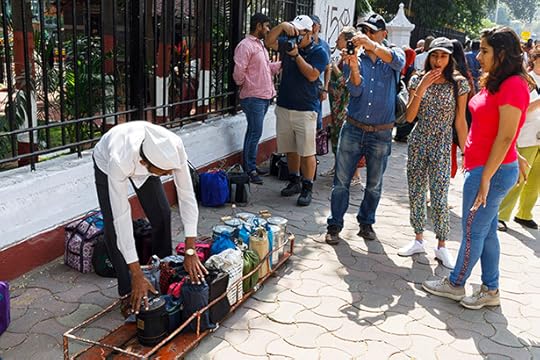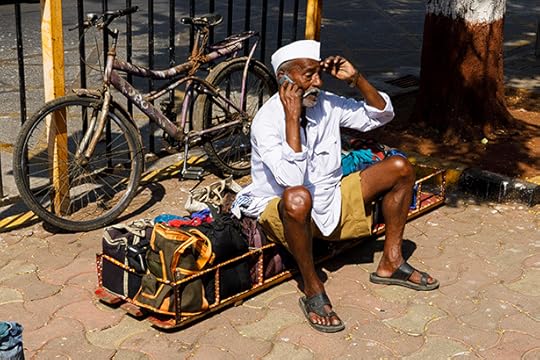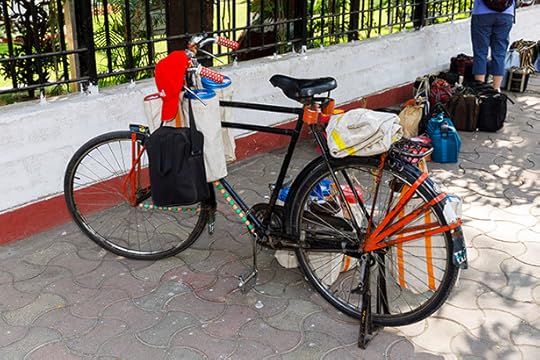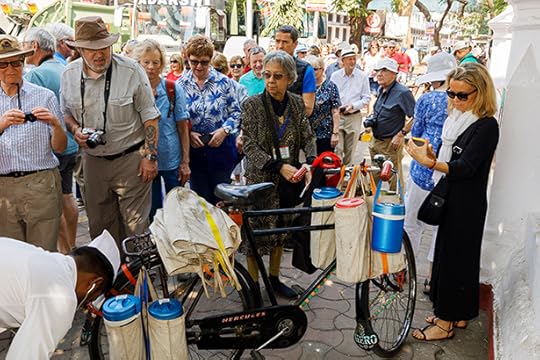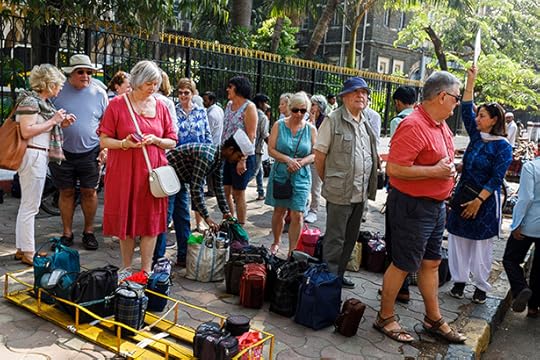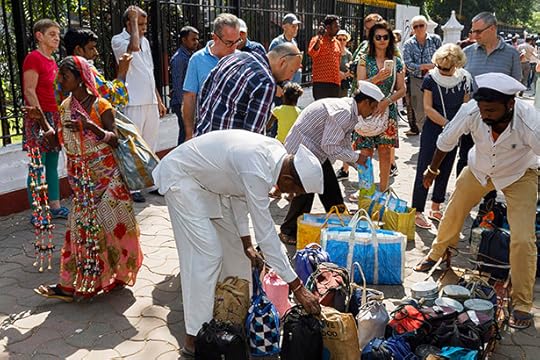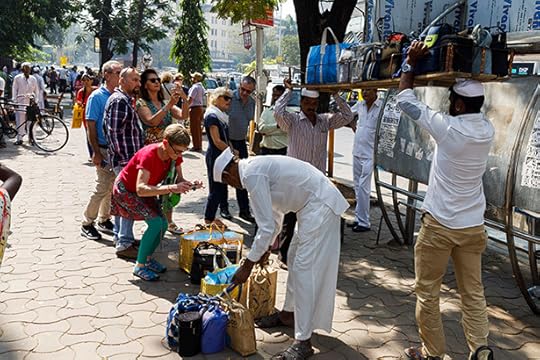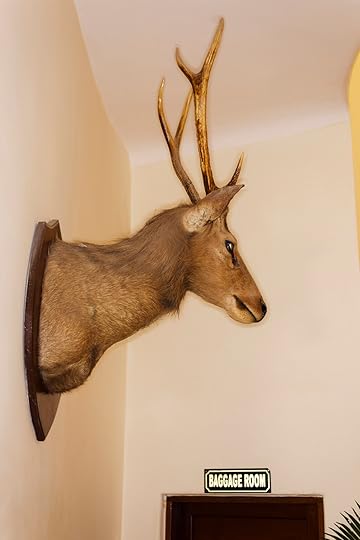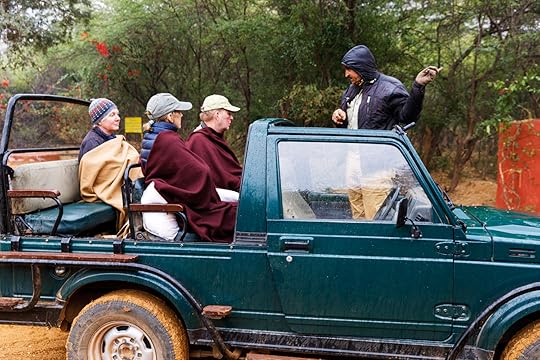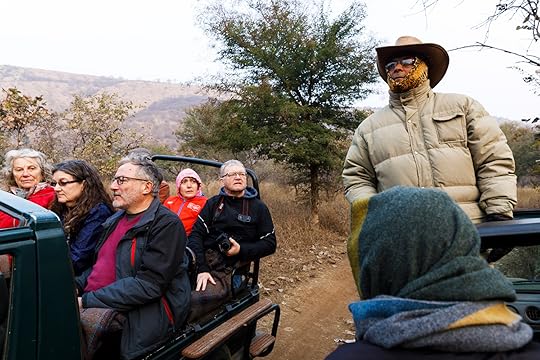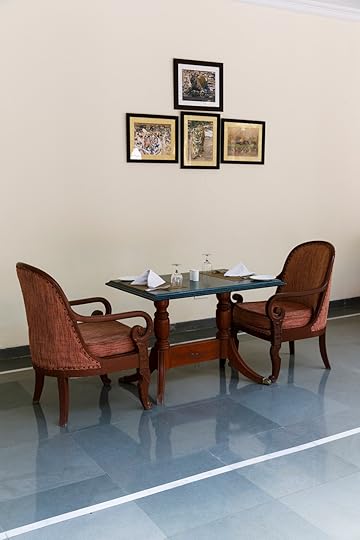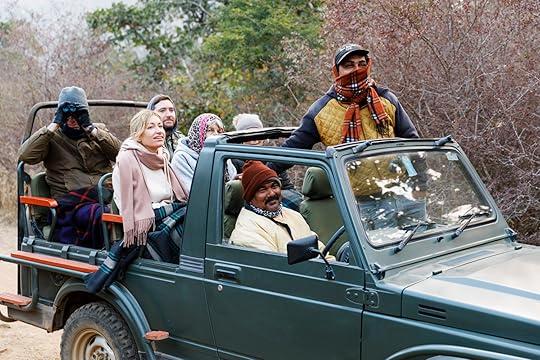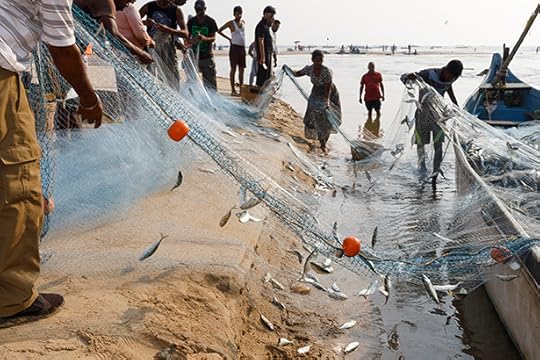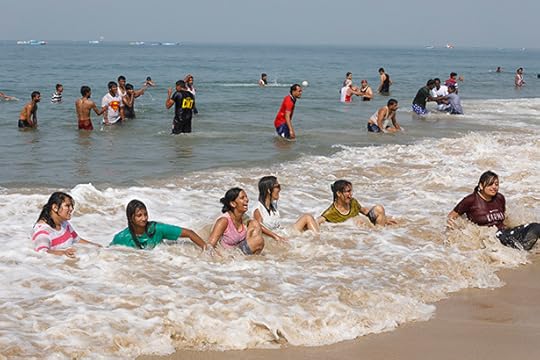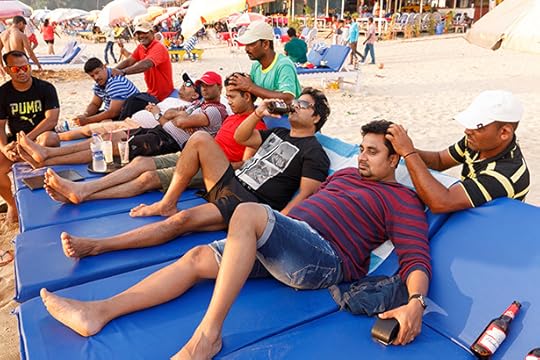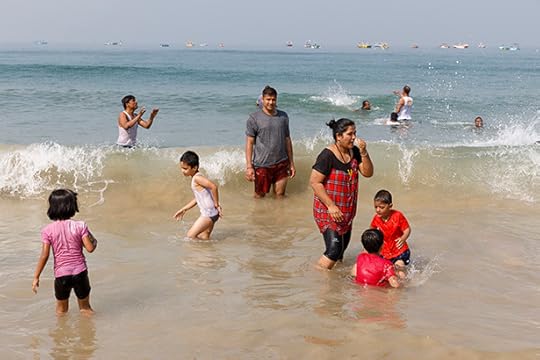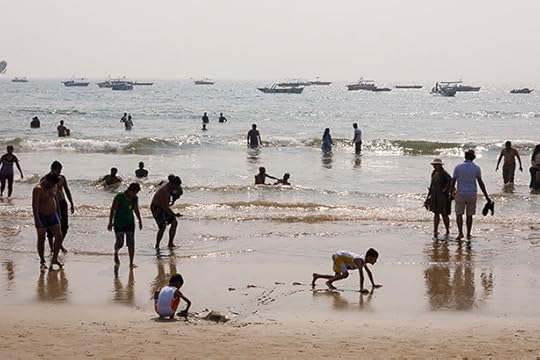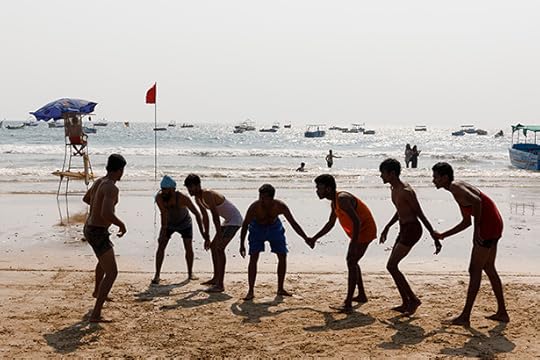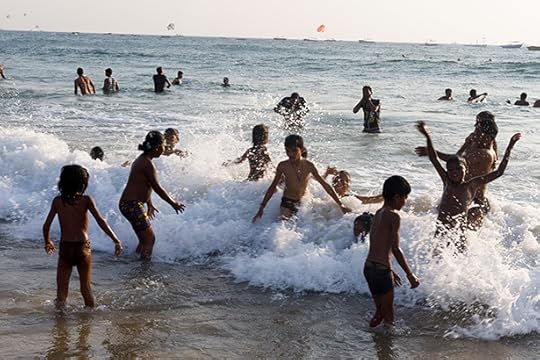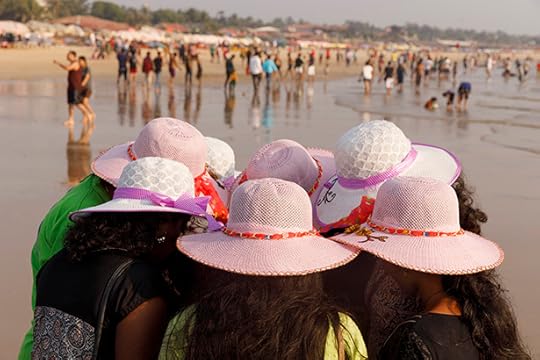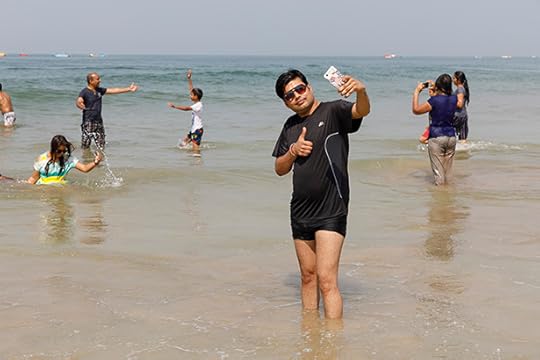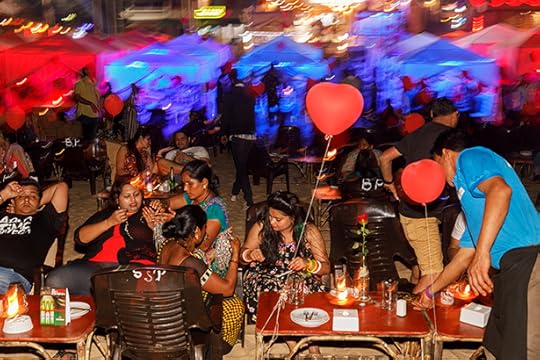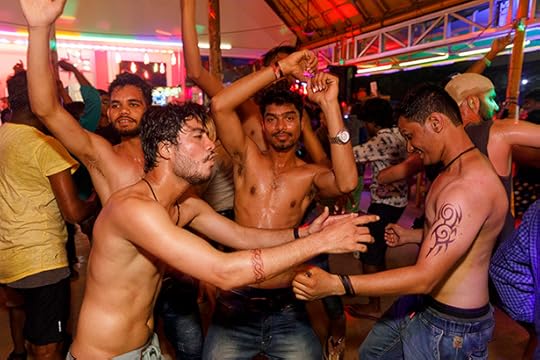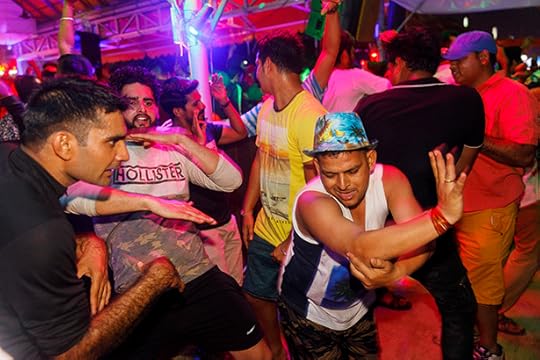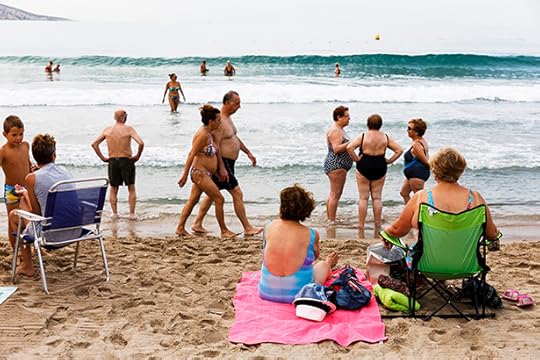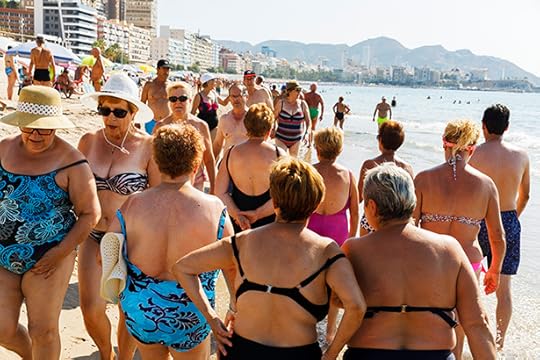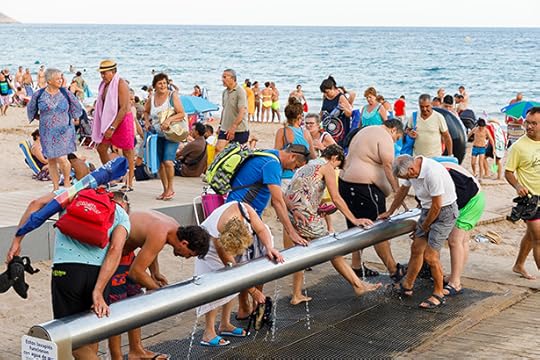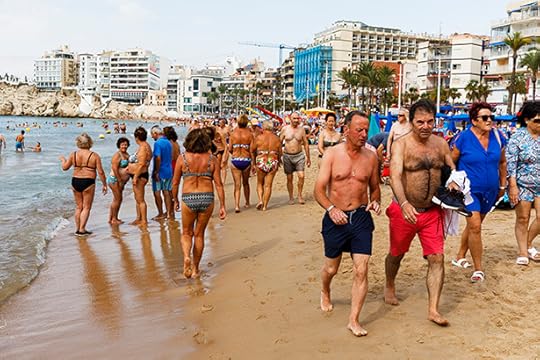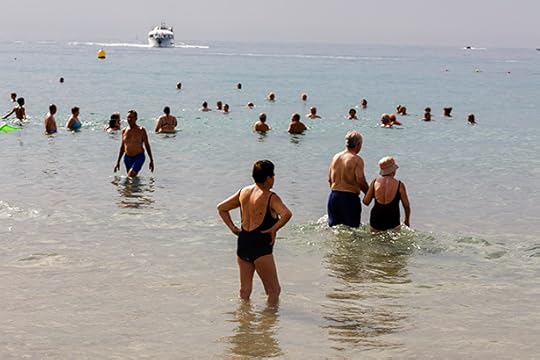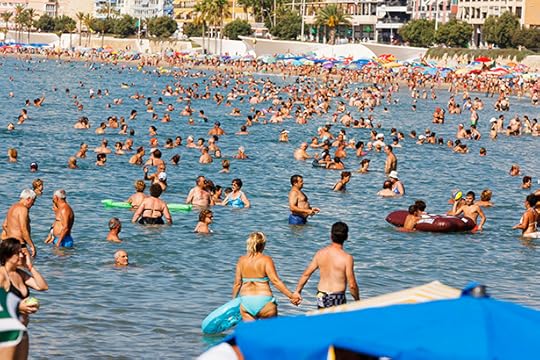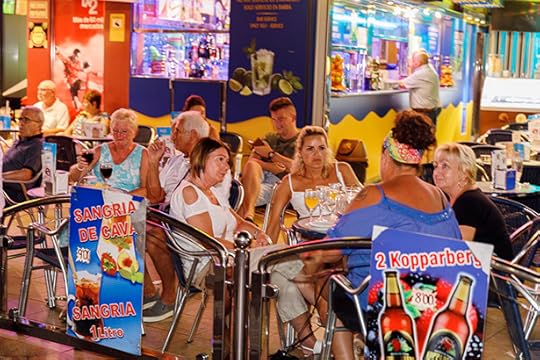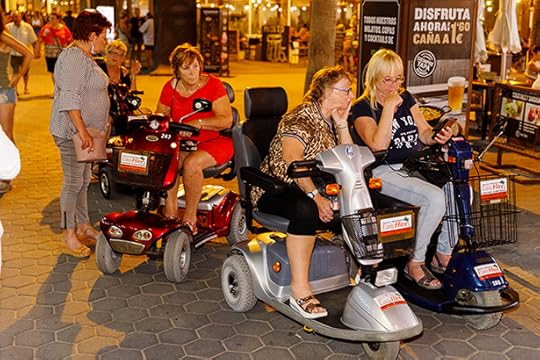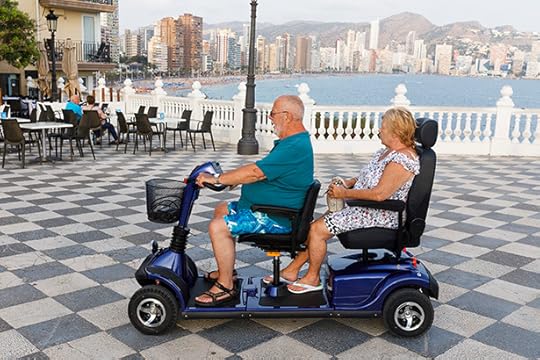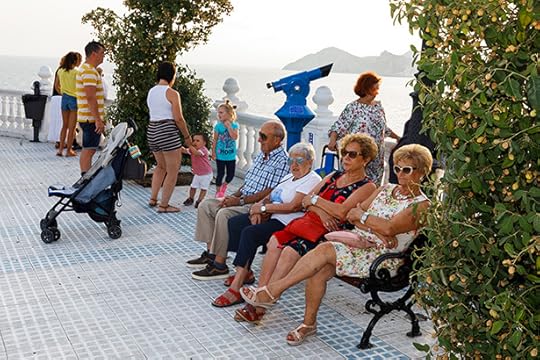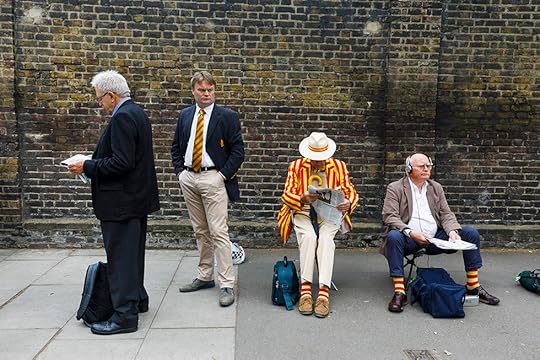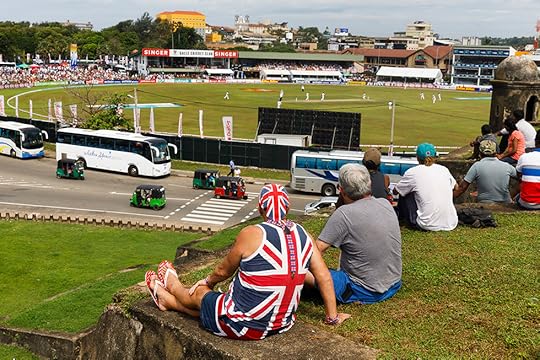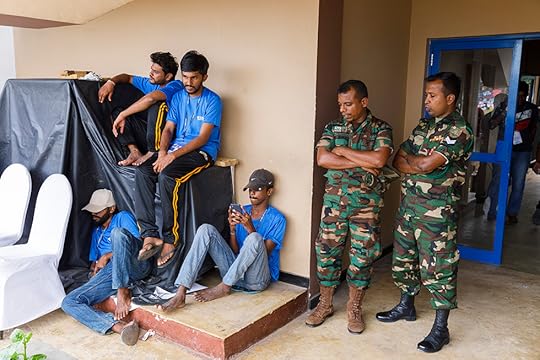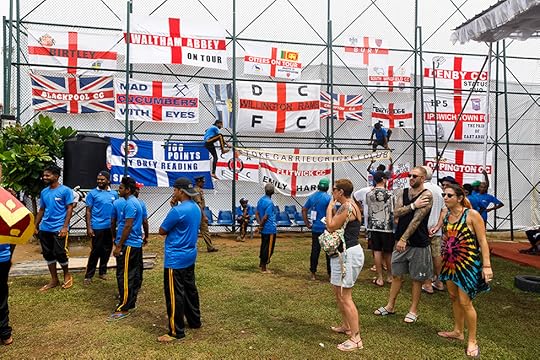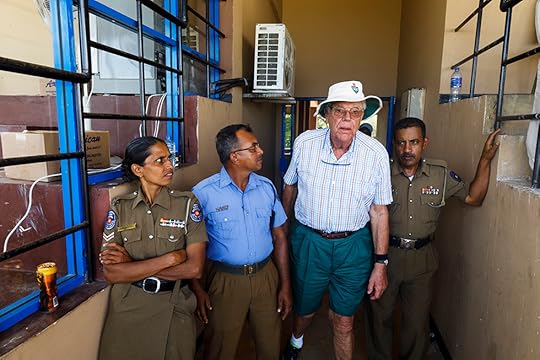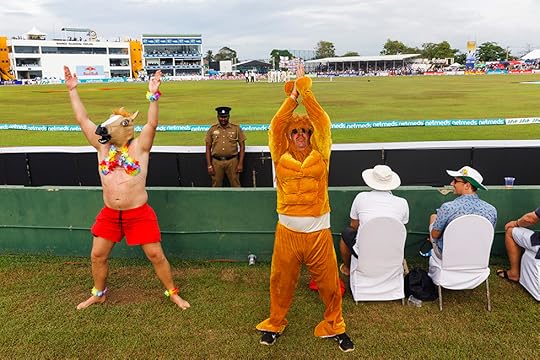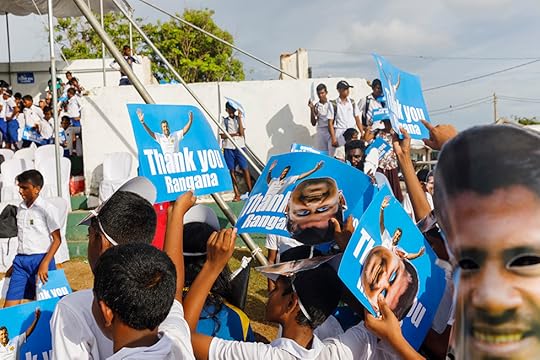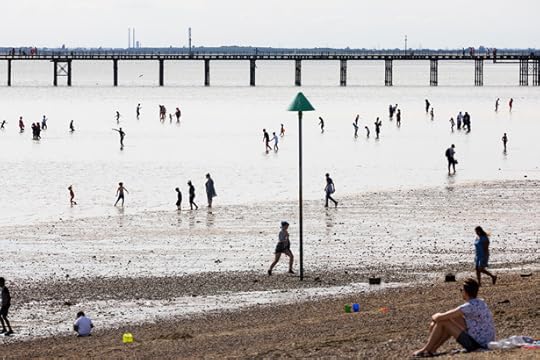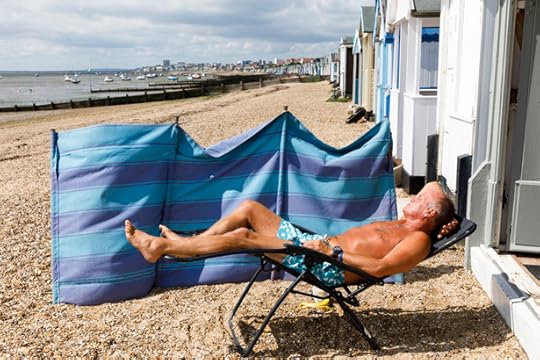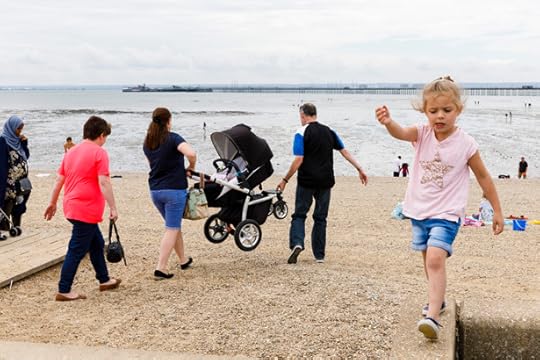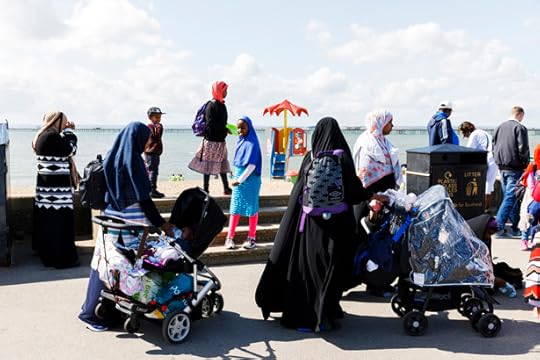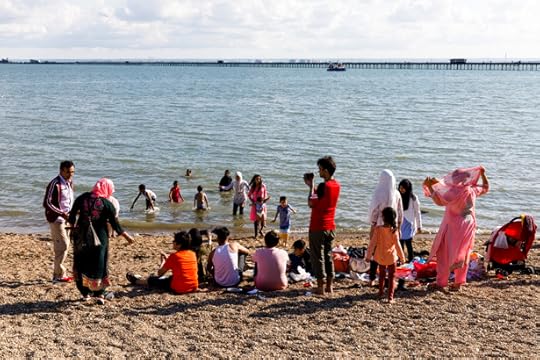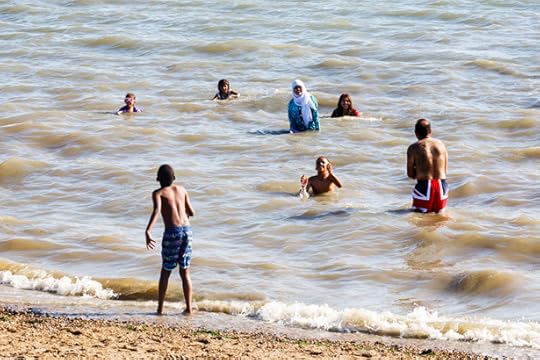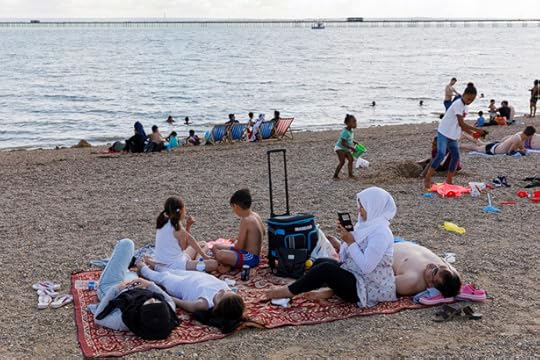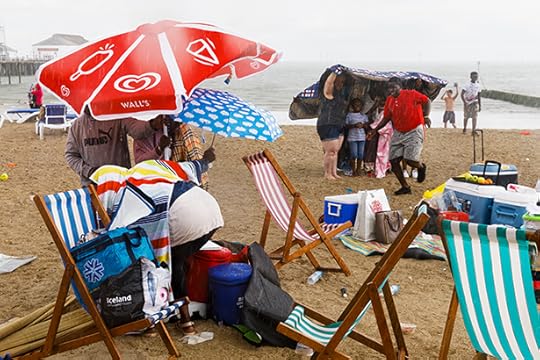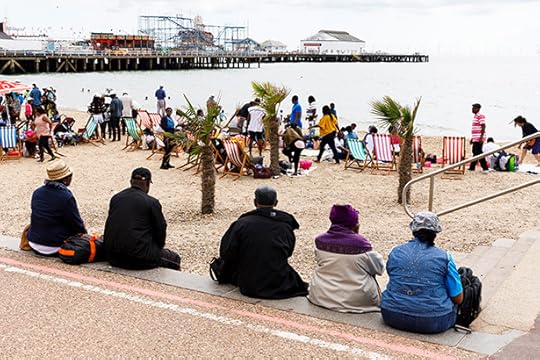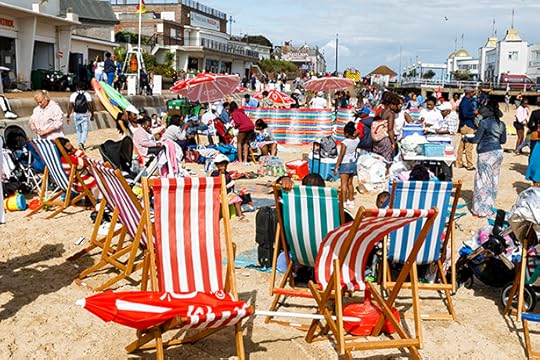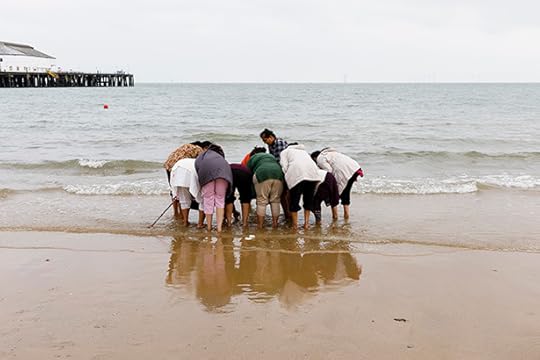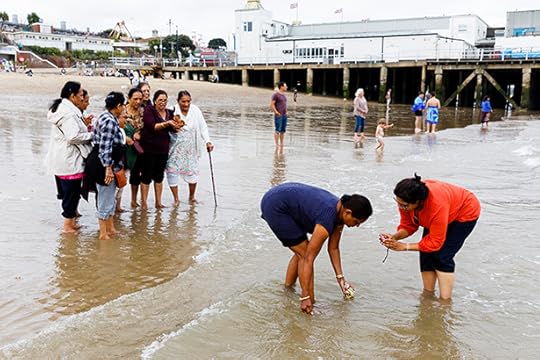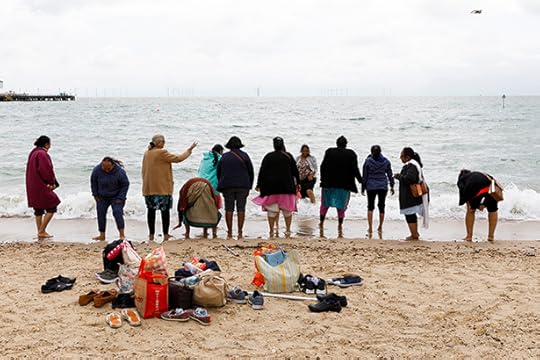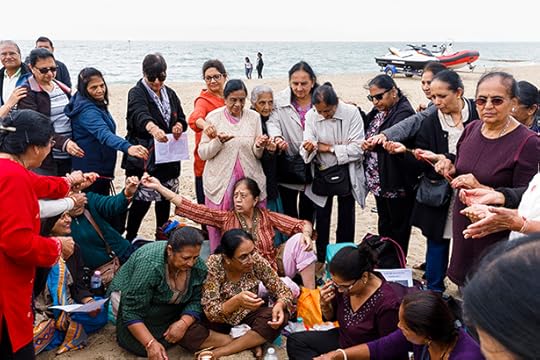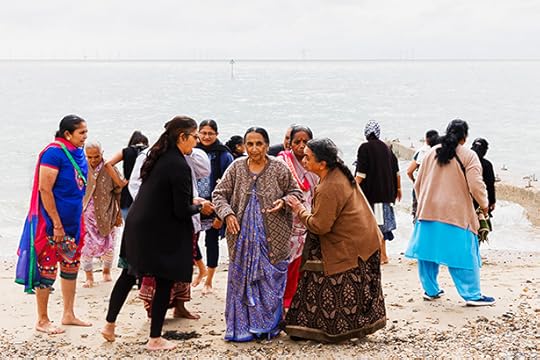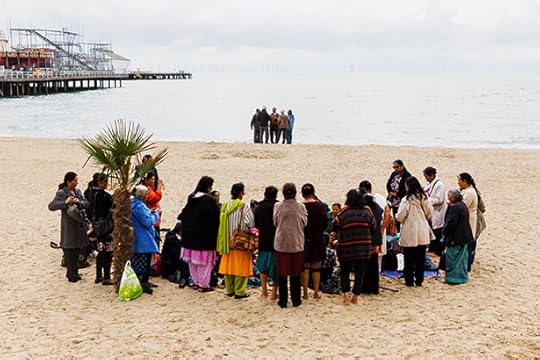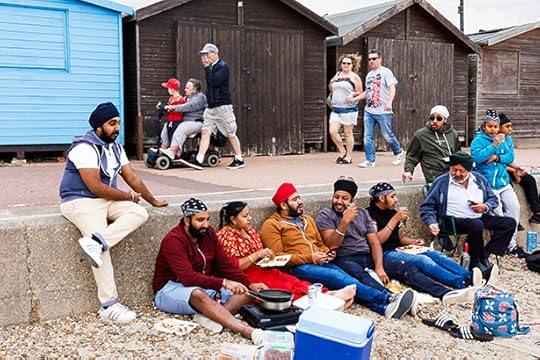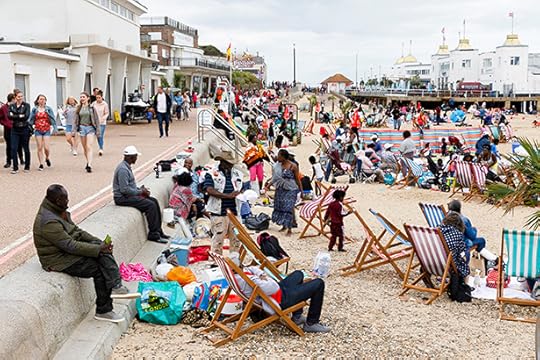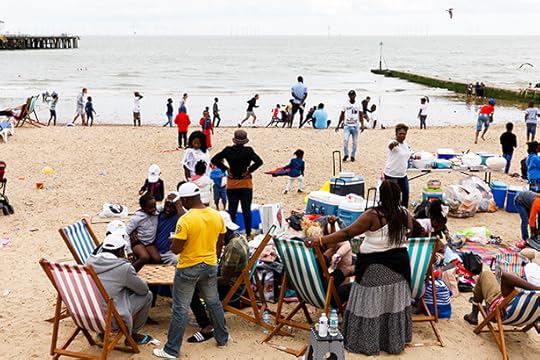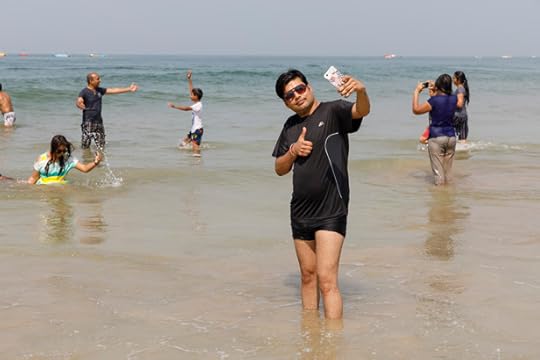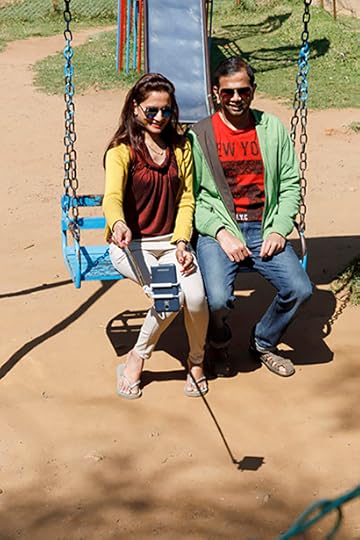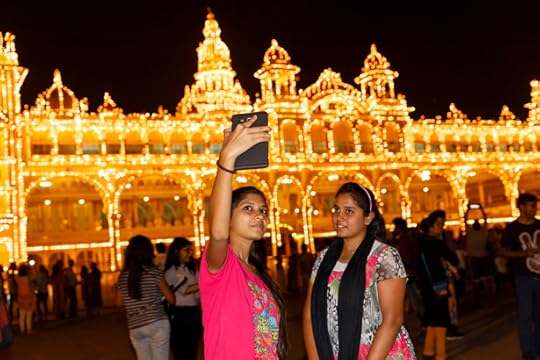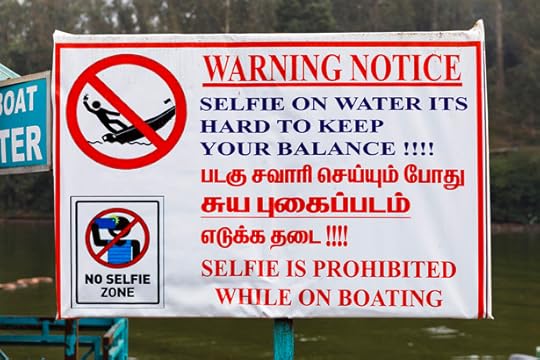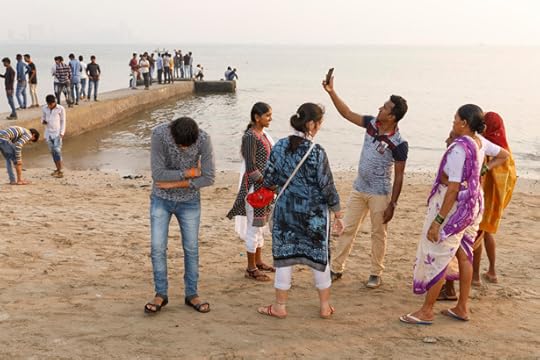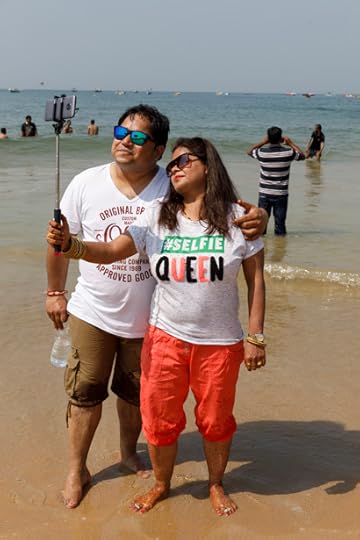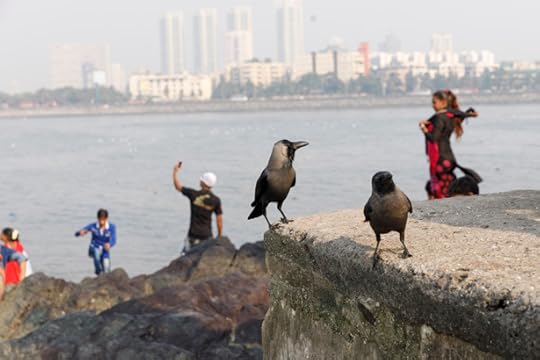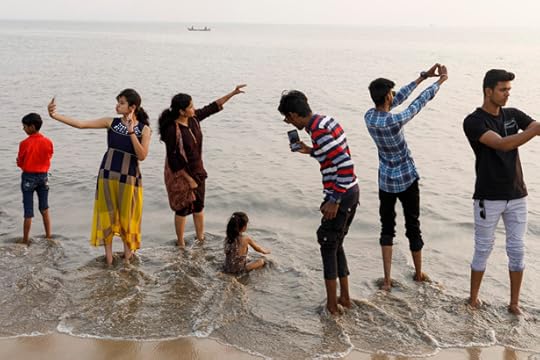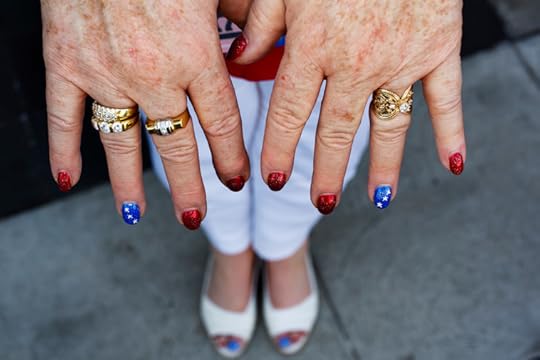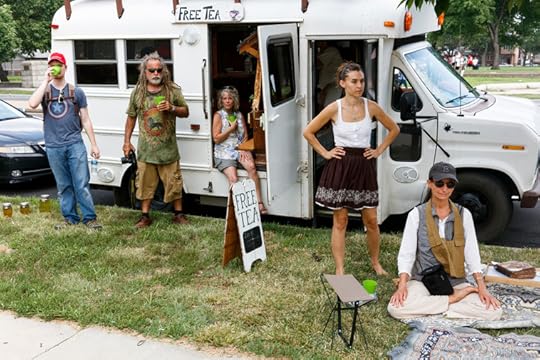Martin Parr's Blog
June 19, 2020
The New Queue
The New Queue
I have been shooting images in the UK for nearly fifty years and one topic that keeps coming up is the humble queue. In Britain we excel in this simple exercise; we do it very well. British queues are orderly, good mannered and woe betide anyone who considers barging in. They would be given short shrift. Some queues are easy to decipher, but not always. Think of the queue as you approach a busy bar, where do you go and who do you acknowledge as you move forward towards that elusive bar person and getting your order taken?
It’s not really a queue in the old fashioned sense, just a slowly moving mass of thirsty clients.
We are now ten weeks into the lockdown of 2020 and one aspect of life that has been re-defined is the simple British queue. Because of social distancing queues have become more extended and ubiquitous. It may indeed be the case that, in the years ahead as the lockdown relaxes, we’ll have to queue for everything, a bit like shoppers in the old Communist countries. In my past, a queue was regarded as a badge of honour as it demonstrated that other people were after what you wanted, thereby affirming your good taste. Now however it is an imposed way of life and I have noted a degree of anarchy creeping in too. Outside a supermarket it is pretty straightforward as they have people supervising the queue. But queues for an ice cream van, or even the rare public toilet, can very easily break down into a non socially-distanced melee.
This new type of queuing is here to stay and will become the new norm. No doubt our in-built queueing etiquette will accommodate social distancing and longer shopping times. We will still experience irritation, not when someone tries to barge in – that is increasingly unlikely – but when a person, busy with their phone, doesn’t move on promptly to the next available line on the pavement.
August 20, 2019
Dabbawalas of Mumbai
Dabbawalas of Mumbai
Famed throughout the world for the way they deliver (and pickup) the lunch tiffin tins to over 5000 people a day, they are one of the unique features of Mumbai life. Subscribers pay 500 rupees a month for this service and legend has it their accuracy of delivery is 100% accurate.
As the assorted wallas pick up the tiffins from hundreds of homes in suburban Mumbai, the main meeting and re-distribution spot is on the pavement opposite Churchgate termini, the main north/south lines in central Mumbai. So at 11.15am they start to arrive, often carrying dozens of packs on a long tray balanced on their heads. Within 40 minutes the sorting has been completed and the assorted bikes and trolleys set off to deliver the tiffin tins.
However arriving at the same time are two sets of other interested parties. One hundred, sometimes two hundred, tourists show up to marvel at the unique procedure, photograph it of course with their eager tour group leaders explaining the system. They are generally blocking up the pavement, and must be a hindrance to the complicated system of number identification, that is key to the successful delivery. Also in the wake of these tourists come the familiar touts peddling their souvenirs, ranging from magnets, elephant necklaces and the usual silk scarves. So the progress of the tourist is slowed down and inevitably showing any interest triggers an avalanche of offers, which can be taken right up the point of departure on both coach and private car.
Quite when this interest started is not known, but it does offer a different perspective to the usual tourist location, although this has now been partly destroyed by it’s very own popularity.
May 30, 2019
No Tiger
No Tiger
Safaris seem to appear on most people’s bucket list. It had crept onto mine, not so much because I love animals, but because I thought a safari could be interesting to photograph. So here I am staying at the Sawai Madhopur Lodge on the fringes of Ranthambhore Tiger Reserve in Northern India. Formerly a shooting lodge for a Maharajah, this a stunning art deco building with a stuffed leopard in the reception and assorted heads of game on the walls. There is even a photo of the Queen with a party of hunters standing in front of a shot tiger taken when she visited in 1961. I hope Prince William doesn’t see this. The reason for this hotel is to feed the safari business, and nothing else. Every conversation you have with your fellow guests starts as follows: ‘Have you seen a tiger?’
So it’s 6.30am, still dark, and I’m dressed for winter as it is pretty chilly, not what you expect in India. Along comes our open top jeep with four other safari goers on board. As we drive at speed along the potholed streets, it’s not just chilly but more like bloody freezing as I am perched at the back, with the wind chill coming straight at me. Luckily the organisers supply blankets and these give some relief. It’s quite a sight.
Luckily for us, today’s route through the reserve is one of the nearest and soon we take a sharp right off the main road and head through iron gates. We have a local driver and an Indian guide who looks like a hangover from the Raj days and he starts to tell us facts and figures about the tigers. He explains they are solitary and nocturnal creatures, that the reserve covers hundreds of hectares, and one starts to suspect he may be preparing us for the potential lack of tiger viewing. We spot deer and antelope, but to be honest there is more wildlife to be seen on the road outside through the villages with numerous load carrying camels and wild boars sniffing through the street debris. The landscape though is stunning, and now we are starting to climb, and we are being thrown around as the track is pretty rough. I’m thinking to myself, is this a form of torture? It’s cold and we are being jolted something terrible, but hey, the views are great. The main excitement for me is spotting other jeeps full of safari goers that I can photograph.
So this goes on for about another ninety minutes and then we head back. The sun is starting to break through the morning mist and it is warming up. But we have not seen a tiger, just tiger footprints. Back at the lodge breakfast is served, and very welcome too.
I am back on the jeep at 2.30pm about to head out again, and I have to say things are looking up. It’s now much warmer and the track on this next excursion is considerably smoother. However the hitch for this trip is the terrible dust along the main road that is being upgraded. It is therefore a gravel track with numerous lorries, buses and camel carts, all throwing up clouds of dust. We get into the reserve and after about an hour we are told a tiger has been seen! Our driver takes us at breakneck speed to the supposed sighting spot and lo and behold we see a hyena. Our guide claims they are much rarer than tigers. At the end of the drive we sit in the spot where our guide had seen a tiger that morning, along with about half a dozen other jeeps. We wait for thirty minutes then pull away and head back.
The following morning, same time, same cold, same rocky ride and now our spirits are flagging and to top it all it starts raining. There is no tiger to be seen at all. So that is the safari well and truly removed from my bucket list.
April 2, 2019
Baga Beach
Baga Beach
Text by Susie Parr, photographs by Martin Parr.
The northern end of Baga Beach curves into a sandy palm-fringed estuary, where the heron waits and fishermen sort their nets in still water. An earth path winds from the rough concrete road bridge through an area of scrubland lined with beached boats, past a small temple, a pay toilet and a few ramshackle stalls selling swimwear – mainly bathing trunks, as the majority of bathers are men. The path is choked with empty bottles, discarded cigarette packs, dirty nappies, plastic bags. Cows sniff at the piles of smoking, malodorous trash then lumber slowly onwards in their unending search for grass; feral dogs pant in the shade. After this inauspicious start the open vista of the beach is a welcome sight: miles of white sand, green-blue sea, the water’s edge lined with rows of sun beds and umbrellas, cafes and restaurants ranged behind. The inland odours and oppressive heat are dispelled by Baga’s lively breeze.
Tramping along, feet already burning on the hot sand, the visitor checks out the prices of beds and umbrellas; these range from 150 rupees per day to free if you buy a drink at the host cafe. All along the waterfront, litter from the previous day has been swept into small, regularly spaced piles. The empty beer bottles, cigarette packs, water bottles and plastic straws are slowly gathered up and – for a while – the sand is clean. At 10 o’clock the lifeguards arrive, assessing conditions and putting up appropriate flags. The beach has big waves, a strong undertow and powerful rip tides. At the first sign of a sinister current, the life guards set up a vigorous chorus of whistles and gestures, waving to the bathers bobbing in the surf, urging them to move to the left or the right, out of danger. Sometimes instructions are relayed through a loudspeaker fixed atop a red jeep. It is impossible to ignore this noise and people obediently shift, like flotsam swept to one side or the other by the lifeguard’s hand. Bizarrely, given their diligence, the guards seem oblivious to the antics of jet skiers who race up and down parallel to the beach, swerving dramatically to a halt often within inches of the bathers, Their indifference may be because such tactics are common on Indian roads, where vehicles veer from lane to lane at high speed, squeezing between lorries, buses, tuk tuks, ox carts, tractors, and scooters bearing entire families including infants.
As regards the water, the lifeguards’ caution is not excessive, as it seems few Indians can actually swim. Rather, they spill into the water and frolic in the surf, waiting for the waves to break over them, shrieking excitedly. The bathers are mostly groups of young men, most clad only their underpants, shouting, splashing, climbing on each other’s shoulders and generally engaging in boistrous displays of horseplay. Few Indian women enter the water; those who do are more cautious and modest, fully clothed in sari, shalwar kameez or even jeans and tee shirt, holding hands with a sister or cousin or hanging on the husband’s arm. Bathers of both sexes lift small children above the waves, dip bare toes in the water, a lifetime of surf-jumping ahead. Few venture out of their depth. As the day wears on the groups become increasingly raucous, shouting excitedly, engaging in rough and tumble and crazy games of tag. These high spirits increase in proportion to the beer consumed, bottle after bottle downed as the sun reaches its highest point then starts to decline. In the hazy late afternoon light, some young men are staggering, some lie giggling at the water’s edge, some throwing sand. Impaired judgement means that many cell phones are ruined by the group selfie in the waves.
Away from this good natured mayhem, older people chat sedately on sun beds, watch movies on tablet or phone, discuss the cricket, and doze. Men stroll along the sand, arms loosely draped across shoulders or hand in hand, deep in conversation. Europeans, some lavishly tattooed, some sporting lurid patches of sunburn, stroll along at the water’s edge or stretch out on towels on the sand to roast some more. Many congregate at a favoured restaurant, where they have their usual sun bed and are on first name terms with the owner, their customary beer served before they need to ask. Sparrows hop on the sand looking for dropped crumbs; dogs slump in the umbrella shade or crawl under the sunbeds. Vendors pass along the sand offering ice cream, selfie stick, small drum, pineapple, water melon, necklace, head massage, coconut, foot massage. As the afternoon fades, more groups arrive into the crowded car park, spilling onto the beach for the spectacle of sunset. The lifeguards clear the water before going off duty. The fishermen push and heave their boats up the estuary channel to the landing stage where they stand in the dusk patiently untangling their catch, fish by shining fish, silver bounty piled into woven baskets. The crows arrive to roost. Overhead, kites wheel on the thermals, searching for scavenge in the last of the light.
When darkness falls, Baga adapts swiftly to night life, a romantic setting for the many honeymooning couples who stay here. Sun beds and umbrellas are stacked away. In their place, tables and chairs are set on the sand, candles lit. Waiters hover. The sand is lit with arc lights and by the illuminations that drape the beach front, pulsing and multi coloured. Some bars create intimate booths on the sand, white curtains lit to a glowing red. Music pounds from speakers. The beach is still full of people, cabals of young men sitting on the sand drinking, some still bobbing in the shallows as the waves break white in the darkness. Now is the toddlers’ time. In the cool of the evening young children can play happily in the sand, mum and dad sitting close by, gazing at the crashing sea. Vendors capitalise on this young market, hawking illuminated toys that spin, whizz and glow. Aside from these small families and the dreamily drifting couples, the majority of hookah smokers and restaurant goers is made up of groups of men, generally older. It is very unusual to see women take a table and make an order, as many will be doing in the foreigners’ enclaves further down the beach. At Manu’s, Sunday night is disco night; posses of young men – and one or two young women – thrash around to Indian house music.
On the beach, a young bull wanders restlessly between the strollers; they move cautiously out of his path, avoiding his mad stare. Empty beer bottles accumulate on the sand. Some bars show cricket (India vs South Africa) or football (Delhi vs Goa). Groups of men sit on plastic chairs, absorbed in the commentary, their backs to the sea. Across the estuary, on the rocky headland, the chapel cross lights up, a still, electric blue.
February 7, 2019
Benidorm
Benidorm
Text by Susie Parr, photographs by Martin Parr.
The commonly held misconception that Benidorm is an enclave of British tourism was demonstrated in 2018, when a woman complained to Thomas Cook that her holiday had been ruined by the number of Spanish staying at her hotel. ‘Could they not find somewhere else to go on holiday, was her plaintive query. In fact Spanish holiday makers far outnumber the Brits and other Northern Europeans at the resort.
The September beach demographic is clear. Older people, in their 70s, 80s and 90s, congregate in tens of thousands on the sand. Most arrive well equipped for a day at the beach, settling down with chairs and parasols, newspapers and crosswords. At the water’s edge, along the entire length of Benidorm’s two main beaches, a strip of hard flat sand makes for easy walking. From early morning, it is thronged with elderly folk taking exercise before the sun becomes too intense. While a few walk alone, most promenade in couples or small groups; the hum of their conversation providing a gentle soundtrack.
Benidorm’s gently shelving sand gives easy access to the warm, clear water. Even those with dodgy hips and newly replaced knees can easily cool off. They enter the water clutching walking sticks, gripping the arm of husband, son, or friend. The chat continues in the water, as people bob like jetsam, or stand waist deep, heads together, engrossed in talk. Towards noon, the water is thick with bodies. The low buzz of countless, endless, ongoing conversations intensifies as more people enter the water, the heat builds and cumulus clouds gather over the mountains. There is of course, much to talk about: ailments, operations, deaths, money worries, wayward sons, unruly grandchildren, difficult neighbours.
Standing in the shallow water in front of the shaded ‘playas accesibles’ area, where wheelchairs are parked in orderly rows, a group of women break through the hum of conversation by singing a popular song. The chorus taken up by the countless elderly bathers standing nearby, a spontaneous watery sing-song capturing the collective spirit of this most Spanish of beaches
One striking feature of Benidorm’s beach society is the fact that the Spanish seem unabashed by the flab, sag and wrinkles of old age. Many older women wear skimpy bikinis or even go topless, literally comfortable in their own skins. This is particularly arresting given that – back in the 50s – Benidorm was subject to a ban on bikinis instigated by the church and supported by Franco. Fascist and Catholic decorum was overturned by the mayor, Pedro Zaragoza, who was instrumental in developing the resort’s infrastructure with his vision for mass tourism. In 1953 he travelled to Madrid on his Vespa scooter, appealing directly to Franco to allow the pale-skinned northern holidaymakers to wear whatever they wanted. Outfaced by the zealous mayor, Franco backed down. Benidorm rapidly became, and remains, Spain’s largest seaside resort.
By 2pm the Spanish have mostly abandoned the beach, headed for lunch in one of the many pinxtos and tapas bars (outlets line an entire alley in the old town), followed a siesta. They will return after 5.30, resuming their station on the sand and picking up the threads of conversation. Northern Europeans slog the afternoon out, splayed on towels and sun beds, tattooed flesh broiling. Many Brits return to Benidorm year on year, joining encampments of old friends on the sand and cyclically re-colonising their favoured British-run bars. Many older people winter here as it is warmer and cheaper than the UK. Many die here, far from friends and family, unable to afford to live at home.
British of all ages come to Benidorm and September sees an influx of the middle aged, taking advantage of lower prices now that the schools have gone back. Members of this cohort seem to take a particular shine to the mobility scooters that can be hired for a few euros a day. Single and tandem motorised buggies save the trouble of walking long distances or uphill in the heat. While some scooter users are clearly aged, infirm or disabled, many are simply overweight or unfit, their poor condition not improved by smoking. Driven with elan by an able bodied, relatively young person, the mobility scooter becomes something of a status symbol, whirring up the narrow lanes of the old town and along the tree-lined promenade.
At the water’s edge, crowds of Spanish pensioners stream back and forth, passing each other in the soft morning light. The thought must cross the collective mind that in ten years time, these early walkers will have disappeared, their footprints will be washed away, and their place on the sand taken by the next generation of the old.
January 7, 2019
The Barmy Army in Galle
The Barmy Army in Galle
This summer I had the pleasure of finally getting to shoot photos at Lords, ‘the home of cricket’ in north London. As a bastion of sporting tradition and establishment life, it was well worth the wait. The members all wear jackets and ties, and queue outside from the early hours to get the best seats.
I had a question for their press office. Which cricket ground in Asia would be the most interesting to see a test match? The unanimous answer came back, Galle in Sri Lanka.
So here I am, six months later, about to drive into Galle and witness the first of three test matches between England and Sri Lanka. One motivation for this visit would be to witness the now legendary Barmy Army in action. These are the loyal followers of the English cricket team that travel to support the team when they tour. Rather touchingly, this name was coined by Australian cricket fans. In the mid 90s the English fans would travel all the way Down Under to witness, with depressing regularity, England lose another match. The assumption was that these fans must be mad, hence the name.
The Barmy Army has grown into a huge and successful travel company. Members are identified by their distinctive white tee shirts. The Barmy Army has also become the generic name for travelling English cricket fans.
As I walk into the ground I can see many hundreds of people in position in Galle Fort, ready to watch the match. The fort’s ramparts, high above the cricket ground afford the best view possible of a major sporting event that can be had for free, and thus add to Galle’s fame and notoriety. The fans spread themselves along the high walls, often in quite precarious positions. Although this is free, actually entering the ground doesn’t cost much either: around $2 a day.
In the ground itself, most of the crowd are English, as although cricket is the national sport here in Sri Lanka, it seems there is not as much enthusiasm for a long drawn out, five-day test match. The sudden death, one-day matches most appeal to Sri Lankans.
The match is about to start and I need to locate ‘Billy the Trumpet’; he leads the traditional rendition of Jerusalem in the first over (an over is unit of six bowls) and sure enough his virtuoso playing starts up and the singing echoes round the stadium. Everyone knows the words as it is like the second national anthem after God Save the Queen. Billy Cooper, a professional trumpet player, was kidnapped by the Barmy Army about twenty years ago and has been their musical mascot ever since. Now we settle down to five days of cricket, for this is a very long game indeed.
Another tradition that gets going before the match begins is the hanging out of assorted English flags, some emblazoned with the names of football clubs. Small sums of cash are offered to the army of groundsmen to hang these in prominent positions. They are thus picked up by the TV cameras and broadcast to the world. You can also see these flags hanging from the Fort.
A day’s cricket consists of three sessions, and the timings run with clockwork precision. The morning is 10am -12pm. At Lords you will see hampers, champagne and a delicious spread being laid out at lunch. Not in Galle, for here you grab a hot dog, some pot noodles and of course, another beer. Then after forty minutes back to cricket before they break for tea at 3.40pm. Who else but the English would do such a thing? Well of course, all the ex-colonies, which is basically where cricket is played (with the exception of Canada). After the British colonies gained independence cricket was one of the surviving legacies, along with the ability to make a good cup of tea.
During the last session, between 3 and 5pm , the Barmy Army are coming into their own, fuelled by generous quantities of beer. Billy is leading assorted ditties, some of which reference English players such as the bowler Moeen Ali with a traditional song : ‘One man went to Mo. Went to Moeen Ali’ Other songs reference the Barmy Army itself. ‘We are everywhere and we are noisy. We are the Barmy Army.’
As well as the UK base, the Barmy Army have clubs and outposts in cities such as Dubai and Sydney; these have also shown up for the match. Fancy dress is often worn and the fans’ behaviour gets bolder throughout the day as more beers are consumed. Often people forget they are here to watch cricket, but I guess that could be said of many sporting fixtures, especially those that involve drinking.
It is now day four and the match is nudging towards the close. England have to bowl Sri Lanka out to win and this possibility is tantalisingly close. Rangana Herath, a very respected Sri Lankan fast bowler, is playing his last match and the small but noisy gathering of Sri Lankan school kids have been handed Rangana posters and face masks. These have helped to liven up the local support and it feels more like a proper match.
Rangana is bowled out and round of applause, from both camps, echoes around the ground, the Fort spectators also joining in. After one more wicket, England have won the match which has been very speedy, closing early at the end of day four. The Barmy Army leaves the ground jubilant, smiling broadly; they have not won a test match abroad for nearly two years now. Perhaps they are not so barmy after all.
Martin Parr
August 8, 2018
Southend
Southend
Text by Susie Parr, photographs by Martin Parr.
When the tide goes out at Southend, it really does go out. The coarse, gritty sand of the beach gives way to an expanse of dark gullies and mudbanks that stretch for more than half a mile. Here, plover and turnstone stalk the slime, investigating what the sea has left behind. In the distance small figures can be seen digging for bait, hopefully not oblivious to warnings about the treacherous speed of the incoming tide. Beyond the mud, in the middle of the estuary, the Thames becomes a sliver of greeny blue that can still be navigated by the tankers heading slowly out towards the North Sea. And, in the distance, it is possible to make out the windmills, chimneys and cranes on the Medway Estuary flatlands: the Isles of Sheppey and Grain.
Southend holiday-makers don’t generally seem dismayed by the lack of sea. Many plant themselves on the gravel beach, looking out over the mud, to picnic, doze in the sun and wait for the water’s return. Others head towards the raucous mayhem of the funfair or trundle by train down the longest pier in the world, stretching out into the estuary for over a mile. A pilgrimage to the more sedate areas that lie at either end of Southend’s miles of beach is also on the agenda. At Leigh-on-Sea you can admire picturesque fishermen’s cottages, sample a pint of prawns or a bowl of cockles, and sit on a pub bench watching the fishing boats navigate the channels that wind through the mud. And at Thorpe Bay, the gaily-painted beach huts, with their ladders running down to the shingle, create a quintessentially English seaside scene.
Southend’s central beach area – Southchurch – couldn’t be more different. Here, holidaymakers from north east London and the Essex conurbations wander in vibrant family groups. Passing by, you catch snippets of conversation in a multitude of languages: Urdu, Yiddish, Arabic, Polish, Mandarin, Italian. Could this be the most concentratedly diverse patch of seaside in the world?
Back on the sand, those who have been patiently waiting are rewarded as the sea rushes in, grey brightening to olive green in the afternoon sun. And some choose to bathe, despite the choppy breeze from the estuary that whips up the waves. Many bathers observe strict protocol: a Sikh family frolics in the water fully clothed. And a Hassidic couple, who at the same time every afternoon carry their baby’s pushchair to the same spot on the shingle, enter the seawater separately, the man plunges in the shallows in a billowing white shirt, black trousers and kippah, and the woman ducking down in blouse, skirt, wig and hat. On Southend’s beach in 2017, modesty is required, just as it would have been 150 years ago.
As the afternoon fades, the families disperse to their guest houses, or return home after their day-trip. The litter left behind from a multitude of picnics will be scraped from the sand by a tractor, leaving it clean and raked ready for the next day’s visitors.
April 5, 2018
Clacton
Clacton
Text by Susie Parr, photographs by Martin Parr.
In contrast with Southend’s straight, endless miles of harsh, gravelly sand, Clacton’s seafront offers delights on a more human scale. The beaches are smaller, more curved, and the yellow sand is soft. Here, instead of collapsing, sandcastles stand firm when the bucket is removed. Even the fun fair on the pier seems gentler, and more geared to families with children. At the end of the pier, a sleepy cafe sees few customers apart from one or two performers from the Fantasia Circus coming in to re-fuel between sessions on the high wire.
On a sunny Saturday afternoon, fifty worshippers from St Francis’s Catholic Church in Stratford, East London, pile out of their coach and on to the sand by the pier. Deck chairs are arranged, tables set up, cool boxes unpacked, wind breaks hammered in and barbecues lit.
This seems to be the beach of choice for church day trippers; another group from Wembley sets up camp nearby. There is some paddling but not much swimming. Lana, who is wearing a Jesus Loves You tee shirt, says that these outings -carefully planned for months- are good for people who can’t go on holiday, and especially important for the children. Having lost her own mother last year, she now has no reason to travel to Jamaica, yet she needs a break from London. The day trip to Clacton presents the ideal opportunity to get a change of scene, a breath of sea air, and enjoy platefuls of chicken and rice in good company.
A couple of days later, on the same beach, a group of Hindus from Ilford are trying out Clacton as the venue for a ceremony to mark the end of Shravan Month. They have fasted intermittently through the month and have now come to the sea to pray, sing and make offerings to Lord Shiva.
Although there are some men in the group, it is predominantly older women who take part in the ceremony, wetting their feet in the sea, making a model of Lord Shiva from sand gathered at the water’s edge and laying out candles and offerings of food. They have to come to the seaside for this ceremony, and hitherto – for some reason – have chosen Bournemouth, a five hour journey from home. Clacton is much easier for them, being only 90 minutes away.
Further along the seafront, a large family gathering of Sikhs, hailing from many different parts of the UK, congregates on the sand. The women spread out sheets and blankets, sitting slightly apart from the men, who have wine and barbecue on the go. One man plays the tabla drum and sings softly. He is very nearly drowned out by the golden oldies that blast from the speakers stationed outside Bar 3. Here, lager in hand, weekend DJ Martin is half way through a 7 hour shift, picking out favourite tracks from his files of CDs. Unfazed by the lack of an audience, he is a real pro – introducing each number and smoothly shifting from up tempo disco to relaxed, mellow mood as the afternoon fades.
Along the coast, in Frinton and Walton on the Naze, there is little to disturb the peace as beach huts are unlocked and swept, kettles boiled and owners settled on sun loungers for a quiet chat or a go at the crossword. The sedate atmosphere and homogenous demographic makes nearby Clacton’s beaches, crowded and diverse, with palm trees planted in pots in the sand, seem a million miles away. Londoners bring the world to the seaside. For the Hindu worshippers from Ilford, Clacton is a revelation, and they plan to return.
Susie Parr, March 2018
March 16, 2018
Death by Selfie
Death by Selfie
Here is an unproven statistic: India is the world leader for selfie taking. The only potential competitor would be China , with a similarly large population, but if you refer to the ‘Death by Selfie‘ statistics, India is so far ahead, there is no real competition. It is probably wise to assume that if more people are killed by a phenomenon, then more of this activity must be taking place.
In 2015, 27 people died taking selfies. In both 2016 and 2017, 68 were killed by selfies. Many of the deaths occur when other people step in to try and rescue the selfie taker washed away by freak waves. People also die by going too near a raging fire, or the often occurring stepping backwards off a cliff edge.
The authorities in India are aware of this hazard, and for example in Ooty at, the popular boating lake, all selfies are banned whilst boating, this despite the mandatory instruction to wear a life belt.
But here on the beach of Goa, it is impossible to look round without seeing a selfie being taken. The selfie stick purveyors are also travelling round and these are offered constantly along with a massage, pineapple and all of the others items and services that are available to the beach-goer.
The other observation I would make is that very rarely do selfies come singly; a typical sequence would have many dozens of options perused, and sometimes these extended sessions can take a good ten minutes. I am not sure how the editing takes place, or indeed if these selfies get saved and downloaded.
Another novelty for me is that people often request to have a selfie with me because I am a Westerner and of course I agree. So there must hundreds of images of me floating in Indian cyberspace, untraceable autoportraits that will never be recognised.
Martin Parr, Feb 2018
July 13, 2017
The Conventions
The Conventions
I had seen them on the telly, they always looked like some kind of rally . It was different to how politics are done in the UK, so when CNN invited me to shoot the 2016 Republican and Democratic Conventions , I could not say yes fast enough. First up was the Republicans at Cleveland, and of course the biggest agenda here was Donald Trump, who was equally liked and disliked. Despite some reservations, and many ex Republican Presidents staying away, the overall feel of the Convention was worshiping him and how he could save us against the evil threat of … Hillary Clinton.
The actual Convention is like a cross between a game show and a pantomime. You have the bad guy, in this case Hillary and the saviours of the USA , who will make it great again. Whenever Hillary is mentioned, ( which is frequently) the crowds chant ‘ Lock her Up!’ , whenever the newly proposed security measure are mentioned, the chant” Build that Wall’ and at the drop of a hat the whole crowd can erupt into a ‘U S A’ The chanting and shouting is one of the reasons people love to come to the Conventions. They also take great pride in looking and dressing as patriotic as possible. Stars and stripes are everywhere as my photos will testify.
As well as the delegates, there are huge numbers of media people, I have never seen so many at a single event, all essentially chasing the same footage and photos. They too are part of the scene and as a tribe can be predictable and entertaining. There is a place where all the radio people hang out, where dozens of radio stations broadcast live their observations. In the middle of this is the free Google coffee bar, always a big line.
The first thing you notice when you arrive into Philadelphia for the Democratic Convention is the diversity. In Cleveland there were a mere 18 black delegates from 3000, now there are well over 1000, and suddenly you feel you are back into a better representation of America as a whole. Despite their claimed differences the conventions are very similar. Very carefully stage managed, where any opposition to the elected candidate is suppressed as efficiently as possible. In the case of the Democrats, it is Bernie Sanders, who has a huge following and some of his delegates chose to walk out. Outside of the convention at the entrance and down town there was always a pro Sanders demo taking place. Many of these were also say ‘ Never Hillary’ thus bringing forward a classic Democratic conundrum, if you don’t vote for Hillary what do you do instead?
Both conventions end on the Thursday night with the candidates speech where the crowd are whipped up in a crescendo, and the finale is the famous balloon orgy, where thousands of balloons are dropped from the ceiling and thus giving a fitting climax , and it then turns from a gameshow to kids tea party.
Martin Parr's Blog
- Martin Parr's profile
- 61 followers


